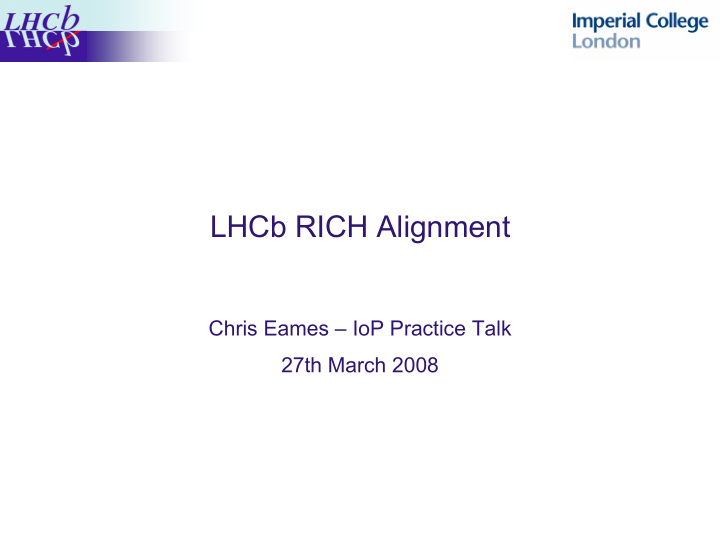



LHCb RICH Alignment Chris Eames – IoP Practice Talk 27th March 2008
Overview • Introduction to LHCb and the RICH detectors • Effects of detector misalignment on data • Determining and compensating for misalignments • Validating techniques using 2006 Testbeam data • RICH Alignment Strategy and preliminary results Chris Eames IOP Practice Talk Imperial College London 27/03/2008 2
LHCb Experiment Tracking Calorimeters Muon Chambers Magnet Vertex Locator Chris Eames IOP Practice Talk Imperial College London 27/03/2008 3
LHCb RICH Responsible for Particle Identification – specifically K/ π separation • • Cover complementary momentum and acceptance ranges RICH 2 Angular Acceptance (mrad) RICH 1 Momentum (GeV/c) Ring Imaging Cherenkov Detectors Chris Eames IOP Practice Talk Imperial College London 27/03/2008 4
LHCb RICH • RICH Detector: → Particles travelling faster than the speed of light in a given radiator gas emit Cherenkov Radiation at angle Θ c → Cone of light focused into a ring on the plane of Photon Detectors by mirror system • LHCb Reconstruction: → Hits on Photon detectors associated with tracks → Θ c Determined for each hit using tracking information and knowledge of RICH geometry → Θ c and momentum used to Identify Particle Chris Eames IOP Practice Talk Imperial College London 27/03/2008 5
Misalignment Effects • Software geometry does not accurately reflect physical hardware • What effect does this have on reconstructed RICH data? • Misalignments between the optical system and the LHCb tracking information: Centre of ring Derived from Tracking Aligned System : Θ c Projection of Cherenkov Angle Θ c Identical for all points on ring Θ c Cherenkov Photon hits distributed on ring in photodetection plane Chris Eames IOP Practice Talk Imperial College London 27/03/2008 6
Misalignment Effects • If the geometry used in the reconstruction no longer accurately reflects the physical hardware – System contains misalignments • What effect does this have on reconstructed RICH data? • Misalignments in the optical system are with respect to the tracking information: Tracking information displaced w.r.t ring Misaligned System : Θ c ( Φ ) Projection of Cherenkov Angle Θ c varies around ring as a function of Φ Φ As a result, the Cherenkov angle resolution of the detector Θ c ( Φ ) decreases Cherenkov Photon hits distributed on ring in photodetection plane Chris Eames IOP Practice Talk Imperial College London 27/03/2008 7
Determining Misalignment • Can misalignments be determined from data? • Change in Cherenkov Angle around ring can be plotted and fitted to determine misalignment parameters • Detector Geometry in Reconstruction can be modified to compensate for misalignment & restore Cherenkov Angle Resolution Simulated misalignment: mirror tilt Change in Cherenkov Angle Theta Phi – angle around Cherenkov ring Chris Eames IOP Practice Talk Imperial College London 27/03/2008 8
2006 RICH Testbeam → Simplified RICH system • Small plane of RICH photodetectors Cherenkov Angle • One Mirror, movable to focus rings on different areas of the active photon detector region Reconstruction: → 80 GeV/c Pion beam from CERN-SPS Photon Detector Hits + Testbeam Setup Tracking + Geometry Photodetector Plane Triggering + Data readout Mirror Beam Radiator Volume Chris Eames IOP Practice Talk Imperial College London 27/03/2008 9
Testbeam Alignment • Testbeam data taken over several runs with different mirror positions • For each run, precise mirror position must be determined from data Unaligned run Unaligned data from Alignment Monitoring Algorithm in Reconstruction Aligned run Data after Reconstruction repeated with updated mirror position Chris Eames IOP Practice Talk Imperial College London 27/03/2008 10
Final Detector Alignment • Full RICH systems far more complicated than Testbeam: → RICH 1: 20 mirror segments, 196 Photon Detectors → RICH 2: 82 mirror segments, 288 Photon Detectors • Design & installation precautions taken to reduce misalignments and identify serious alignment problems → Mechanics designed with little possible freedom of movement → Mirror panes aligned by laser system before installation → Active monitoring of mirrors by Laser Alignment Monitoring System • Software compensation planned for small misalignments of order → < 3 mm translation , 0.5 mrad rotation of whole RICH subdetectors → < 1 mrad rotation of mirror panels → < 0.5 mm translation of photon detector sensors Chris Eames IOP Practice Talk Imperial College London 27/03/2008 11
Alignment Strategy 1. Simulate misalignments of individual components of RICH system to parameterise effects of movements in different single degrees of freedom • Underway for RICH 2 2. Simulate the misalignments in multiple degrees of freedom • Distinguish between rotations and translations by comparing different RICH photodetector planes 3. Misalign multiple components – disentangle by looking at specific mirror and photon detector combinations • Determine optimal order to approach misalignments. 4. Develop minimisation technique to recover main misalignments in one step 5. Blind Alignment challenge using Simulated data Chris Eames IOP Practice Talk Imperial College London 27/03/2008 12
Preliminary Results • Misalignments of the RICH 2 subdetector simulated → Inclusive b events generated → Events reconstructed with misaligned geometry → Background reduction: fitted slices of Φ Peak of distribution found in bins of Φ by fitting Gaussian + Background RICH 2 rotated by 0.5 mrad about X axis Chris Eames IOP Practice Talk Imperial College London 27/03/2008 13
Preliminary Results • RICH 2 misalignments can be identified and calculated from data – detector geometry can be corrected to account for correct positions of hardware Simulated Misalignment -0.5 mrad -0.25 mrad 0.25 mrad 0.5 mrad Chris Eames IOP Practice Talk Imperial College London 27/03/2008 14
Conclusions • Alignment considerations of great importance for all LHC experiments – LHCb RICH systems designed to minimise potential misalignments • Small misalignments in RICH components can be detected and corrected for using first data • Techniques developed and tested using simulation and Testbeam data • Global RICH alignment strategy underway • Blind ‘Alignment Challenge’ to begin soon Chris Eames IOP Practice Talk Imperial College London 27/03/2008 15
Recommend
More recommend